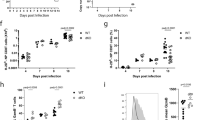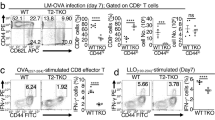Abstract
B and T lymphocyte attenuator (BTLA) provides an inhibitory signal to B and T cells. Previously, indirect observations suggested that B7x was a ligand for BTLA. Here we show that BTLA does not bind B7x; instead, we identify herpesvirus entry mediator (HVEM) as the unique BTLA ligand. BTLA bound the most membrane-distal cysteine-rich domain of HVEM, distinct from regions where the ligands LIGHT and lymphotoxin-α bound HVEM. HVEM induced BTLA tyrosine phosphorylation and association of the tyrosine phosphatase SHP-2 and repressed antigen-driven T cell proliferation, providing an example of reverse signaling to a non–tumor necrosis factor family ligand. The conservation of the BTLA-HVEM interaction between mouse and human suggests that this system is an important pathway regulating lymphocyte activation and/or homeostasis in the immune response.
This is a preview of subscription content, access via your institution
Access options
Subscribe to this journal
Receive 12 print issues and online access
$209.00 per year
only $17.42 per issue
Buy this article
- Purchase on Springer Link
- Instant access to full article PDF
Prices may be subject to local taxes which are calculated during checkout







Similar content being viewed by others
References
Watanabe, N. et al. BTLA is a lymphocyte inhibitory receptor with similarities to CTLA-4 and PD-1. Nat. Immunol. 4, 670–679 (2003).
Han, P. et al. An inhibitory Ig superfamily protein expressed by lymphocytes and APCs is also an early marker of thymocyte positive selection. J. Immunol. 172, 5931–5939 (2004).
Gavrieli, M. et al. Characterization of phosphotyrosine binding motifs in the cytoplasmic domain of B and T lymphocyte attenuator required for association with protein tyrosine phosphatases SHP-1 and SHP-2. Biochem. Biophys. Res. Commun. 312, 1236–1243 (2003).
Suzuki, Y. et al. HAX-1, a novel intracellular protein, localized on mitochondria, directly associates with HS1, a substrate of Src family tyrosine kinases. J. Immunol. 158, 2736–2744 (1997).
Prasad, D.V. et al. B7S1, a novel B7 family member that negatively regulates T cell activation. Immunity 18, 863–873 (2003).
Sica, G.L. et al. B7-H4, a molecule of the B7 family, negatively regulates T cell immunity. Immunity 18, 849–861 (2003).
Zang, X. et al. B7x: a widely expressed B7 family member that inhibits T cell activation. Proc. Natl. Acad. Sci. USA 100, 10388–10392 (2003).
Agata, Y. et al. Expression of the PD-1 antigen on the surface of stimulated mouse T and B lymphocytes. Int. Immunol. 8, 765–772 (1996).
Croft, M. Co-stimulatory members of the TNFR family: keys to effective T-cell immunity? Nat. Rev. Immunol. 3, 609–620 (2003).
Mauri, D.N. et al. LIGHT, a new member of the TNF superfamily, and lymphotoxin alpha are ligands for herpesvirus entry mediator. Immunity 8, 21–30 (1998).
Tamada, K. et al. LIGHT, a TNF-like molecule, costimulates T cell proliferation and is required for dendritic cell-mediated allogeneic T cell response. J. Immunol. 164, 4105–4110 (2000).
Morel, Y. et al. The TNF superfamily members LIGHT and CD154 (CD40 ligand) costimulate induction of dendritic cell maturation and elicit specific CTL activity. J. Immunol. 167, 2479–2486 (2001).
Morel, Y. et al. Reciprocal expression of the TNF family receptor herpes virus entry mediator and its ligand LIGHT on activated T cells: LIGHT down-regulates its own receptor. J. Immunol. 165, 4397–4404 (2000).
Sarrias, M.R. et al. The three HveA receptor ligands, gD, LT-α and LIGHT bind to distinct sites on HveA. Mol. Immunol. 37, 665–673 (2000).
Carfi, A. et al. Herpes simplex virus glycoprotein D bound to the human receptor HveA. Mol. Cell 8, 169–179 (2001).
Kwon, B.S. et al. A newly identified member of the tumor necrosis factor receptor superfamily with a wide tissue distribution and involvement in lymphocyte activation. J. Biol. Chem. 272, 14272–14276 (1997).
Jung, H.W. et al. High levels of soluble herpes virus entry mediator in sera of patients with allergic and autoimmune diseases. Exp. Mol. Med. 35, 501–508 (2003).
Latchman, Y. et al. PD-L2 is a second ligand for PD-I and inhibits T cell activation. Nat. Immunol. 2, 261–268 (2001).
Bodmer, J.L., Schneider, P. & Tschopp, J. The molecular architecture of the TNF superfamily. Trends Biochem. Sci. 27, 19–26 (2002).
McDonald, N.Q. & Hendrickson, W.A. A structural superfamily of growth factors containing a cystine knot motif. Cell 73, 421–424 (1993).
Kirchner, S. et al. LPS resistance in monocytic cells caused by reverse signaling through transmembrane TNF (mTNF) is mediated by the MAPK/ERK pathway. J. Leukoc. Biol. 75, 324–331 (2004).
Wiley, S.R., Goodwin, R.G. & Smith, C.A. Reverse signaling via CD30 ligand. J. Immunol. 157, 3635–3639 (1996).
Shi, G. et al. Mouse T cells receive costimulatory signals from LIGHT, a TNF family member. Blood 100, 3279–3286 (2002).
Suzuki, I. & Fink, P.J. Maximal proliferation of cytotoxic T lymphocytes requires reverse signaling through Fas ligand. J. Exp. Med. 187, 123–128 (1998).
Lee, K.M. et al. Molecular basis of T cell inactivation by CTLA-4. Science 282, 2263–2266 (1998).
Granger, S.W. & Rickert, S. LIGHT-HVEM signaling and the regulation of T cell-mediated immunity. Cytokine Growth Factor Rev. 14, 289–296 (2003).
Paust, S. et al. Engagement of B7 on effector T cells by regulatory T cells prevents autoimmune disease. Proc. Natl. Acad. Sci. USA 101, 10398–10403 (2004).
Taylor, P.A. et al. B7 expression on T cells down-regulates immune responses through CTLA-4 ligation via T-T interactions. J. Immunol. 172, 34–39 (2004).
Murphy, K.M., Heimberger, A.B. & Loh, D.Y. Induction by antigen of intrathymic apoptosis of CD4+CD8+TCRlo thymocytes in vivo. Science 250, 1720–1723 (1990).
Scheu, S. et al. Targeted disruption of LIGHT causes defects in costimulatory T cell activation and reveals cooperation with lymphotoxin β in mesenteric lymph node genesis. J. Exp. Med. 195, 1613–1624 (2002).
Arthos, J. et al. Biochemical and biological characterization of a dodecameric CD4-Ig fusion protein: implications for therapeutic and vaccine strategies. J. Biol. Chem. 277, 11456–11464 (2002).
Arase, H. et al. Direct recognition of cytomegalovirus by activating and inhibitory NK cell receptors. Science 296, 1323–1326 (2002).
Lybarger, L. et al. Enhanced immune presentation of a single-chain major histocompatibility complex class I molecule engineered to optimize linkage of a C-terminally extended peptide. J. Biol. Chem. 278, 27105–27111 (2003).
Ouyang, W. et al. Stat6-independent GATA-3 autoactivation directs IL-4-independent Th2 development and commitment. Immunity 12, 27–37 (2000).
Acknowledgements
We thank D. Fremont, C. Nelson and O. Naidenko for help with tetramer production and for discussions, and V. Grigura and J.C. Walsh for technical assistance. Supported by the Howard Hughes Medical Institute (K.M.M.) and the National Institutes of Health (PO1 AI31238 and P50 HL54619 to K.M.M.; AI33068, CA69381 and AI48073 to C.F.W.; and AG00252 to K.P.).
Author information
Authors and Affiliations
Corresponding author
Ethics declarations
Competing interests
Some of the authors have applied for a patent that concerns the BTLA-HVEM interaction and its uses.
Supplementary information
Supplementary Fig. 1
BTLA does not directly interact with B7x. (PDF 39 kb)
Supplementary Fig. 2
Sequences of HVEM isolated from retroviral library. (PDF 45 kb)
Supplementary Fig. 3
Expression of BTLA and HVEM by EL-4 cells. (PDF 26 kb)
Supplementary Fig. 4
Increased expression of HVEM by Btla−/− lymphocytes. (PDF 49 kb)
Supplementary Fig. 5
Expression of I-Ad, B7.1, BTLA and HVEM on CHO cells. (PDF 56 kb)
Supplementary Table 1
Oligonucleotide sequences used in plasmid construction. (PDF 11 kb)
Rights and permissions
About this article
Cite this article
Sedy, J., Gavrieli, M., Potter, K. et al. B and T lymphocyte attenuator regulates T cell activation through interaction with herpesvirus entry mediator. Nat Immunol 6, 90–98 (2005). https://doi.org/10.1038/ni1144
Received:
Accepted:
Published:
Issue Date:
DOI: https://doi.org/10.1038/ni1144
This article is cited by
-
BTLA biology in cancer: from bench discoveries to clinical potentials
Biomarker Research (2024)
-
Costimulatory receptors in the channel catfish: CD28 family members and their ligands
Immunogenetics (2024)
-
The role of the BTLA–HVEM complex in the pathogenesis of breast cancer
Breast Cancer (2024)
-
Beyond the anti-PD-1/PD-L1 era: promising role of the BTLA/HVEM axis as a future target for cancer immunotherapy
Molecular Cancer (2023)
-
Immune checkpoint inhibitors for multiple myeloma immunotherapy
Experimental Hematology & Oncology (2023)



